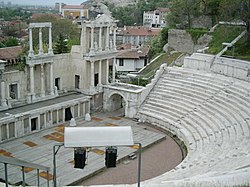Prior to 20th century
| History of Bulgaria |
|---|
 |
|
| Main category |
- 342 BCE – Philip II of Macedon conquered the Thracian settlement Pulpudeva and renamed it "Philippopolis." [1]
- 2nd C. CE – Roman theatre built by Emperor Trajan. [1]
- 250/251 CE – Battle of Philippopolis; town sacked by Goths. [1]
- 340's – Christian church council held in Philippopolis.
- 836 – Town becomes part of the First Bulgarian Empire under Khan Malamir. [1]
- 971 – John I Tzimiskes captures Philippopolis in his campaign against Sviatoslav I.
- 1205 –Philippopolis surrenders to Kaloyan of Bulgaria. [2] [3]
- 1208 – June: Battle of Philippopolis (1208).
- 1262 – Byzantines under Michael VIII retook the city.
- 1323 – Tatar forces attempted unsuccessful siege. [4] [3]
- 1344 – Anna of Savoy ceded the city to Ivan Alexander of Bulgaria.
- 1363 – City taken by Turkish forces under Lala Şahin Pasha. [5]
- 1364 – Ottomans in power; town renamed "Filibe". [1]
- 1420's – Great Mosque built. [6]
- 1440's – Imaret Mosque built. [6]
- 1818 – Earthquake. [3]
- 1832 – Sts. Constantine and Helena Church rebuilt. [1]
- 1835 – St. Nicholas church, Plovdiv rebuilt.
- 1836 – St. Petka Church school established. [1]
- 1844 – Church of the Holy Mother of God, Plovdiv rebuilt.
- 1846 – Fire. [3]
- 1847 – Textile factory in operation. [7]
- 1856 – St. Marina church rebuilt.
- 1861 – Cathedral of St Louis built.
- 1870 - Plovdiv Central railway station opened.
- 1875 – Greek Zariphios School established. [8]
- 1878
- Battle of Philippopolis (1878). [3]
- City becomes capital of Eastern Roumelia per the Congress of Berlin. [1]
- Danov publisher in business.
- Tomasian tobacco manufacturer in business (approximate date). [9]
- 1879 – Naroden Glas newspaper in publication.(bg)[ citation needed ]
- 1881 – International Theatre Luxembourg opens. [8]
- 1882 – Plovdiv Regional Archaeological Museum opens. [10]
- 1885
- "Bloodless revolution at Philippopolis." [11]
- Еко де Балкан (1885) newspaper published.
- 1886 – November: "State of siege at Philippopolis on account of brigandage and Russian agency." [11]
- 1891 – City master plan approved. [8]
- 1892
- August: "First Bulgarian exhibition" opens. [11]
- Exhibition Park laid out. [3]
- Plovdiv Synagogue built. [12]
- 1893
